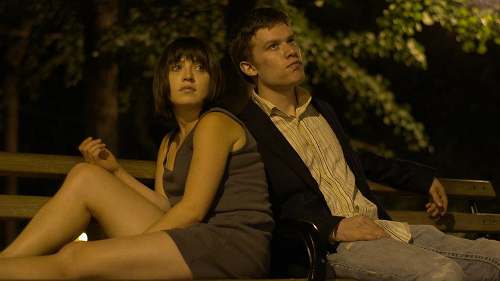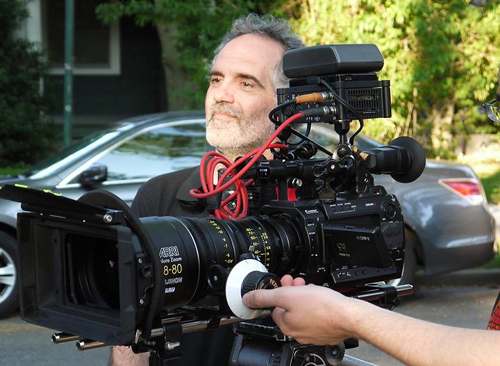 Back to selection
Back to selection
Five Questions with The Unspeakable Act Director Dan Sallitt

The filmmaker and critic Dan Sallitt has created some uncompromising, beautiful films over the years; from his feature debut All The Ships At Sea to the Honeymoon, Sallitt has examined the intersection of intimacy and personal identity with thrilling results. His latest film, The Unspeakable Act, which examines the incestuous sexual desire of a young woman named Jackie (Tallie Medel), had its World Premiere at the recent Sarasota Film Festival (where I serve as Director) and will be screened at the upcoming BAMcinemaFest on Sunday, June 24th.
Filmmaker: I wanted to ask you about the issue of desire. The Unspeakable Act seems, for me, to be directly with the issue of “becoming” through desire, the idea of transgressive desire as a marker for living between two social states; adulthood and childhood. Can you discuss this idea of desire and how it shaped the film. What inspired you to tell this story?
Sallitt: Desire is an exciting subject for movies because it’s so mysterious: it’s like a bit of the unconscious that was accidentally left exposed. It’s the most natural thing in the world for our desire to contradict our more socialized aspects.
I personally don’t see Jackie’s incestuous desire as a transitory thing or part of her passage to adulthood. I think it’s just the way she is, and she will have to keep a lid on that desire in order to live comfortably, will have to cultivate other aspects of herself. By film’s end, I’m hoping that the viewer feels that we are all like Jackie, each with some quirk that makes us feel that we are the only abnormal person pretending to fit into an otherwise normal world.
I think what drew me to this concept is that Jackie is bigger than life, an existentialist heroine who makes her own values and doesn’t internalize the values of society. I recoil from the idea of telling a story in a heroic mode, a la Melville or Leone or Walter Hill; but I seem to enjoy placing something grand at the core of my films, and then playing it way down so that it fits into a mundane context.
Filmmaker: Your film has an almost painterly quality, with lingering compositions and striking lighting schemes that feel so rare in American independent films these days. How did you develop your visual strategy for this film? How did the scope of the film shape the way in which it was told?
Sallitt: All my films have a similar visual approach. I like to use minimum means: the most important visual decisions for me are the simple ones, like what’s in the frame, how much space is around the subject, where the shot begins and ends. The Unspeakable Act turned out to be my first movie without a single camera movement, which wasn’t my goal at the outset. But none of them go too wild on that front. Jackie was a more energetic character than I’ve done before, and the tone is a bit lighter than in my last two movies, so the cutting is a shade more brisk, the framing a shade tighter.
I relied a lot on Duraid Munajim, the cinematographer, for the lighting. I don’t like high-key lighting, and generally don’t want the lighting to comment on or enhance the drama: I always ask for diffused or bounced light, shades of gray, as much natural light as possible. Nestor Almendros is my ideal cinematographer, and the first time I worked with Duraid I gave him a copy of Almendros’s A Man with a Camera as a guide. I didn’t know at the time how much that book would eventually be worth…

Filmmaker: You most recent films have dealt with the push-pull of sibling relationships from a unique point of view. As family is, for most if us, a defining (at least initially) set of relationships in our lives, I wonder if you could discuss your attraction to families, to siblings, as a platform for your stories’ larger concerns (faith, desire, etc.).
Sallitt: I said that Jackie’s extreme nature was my first hook into the project, but the first hook is never enough: you also need a plausible, everyday reality within which to conceal the character’s uncanny nature. And if the hook is going to be incest, the safety net that catches you has got to be the family.
You can make films about the family all your life and never run out of new material. People can’t hide their inner nature in a family context, so you get it all at once, the comfort and the hostility, the affection and the raw unpleasantness. It’s fun to show a family member behaving in a way that seems odd, and then let viewers work it out for themselves that that behavior is perfectly natural and even mandatory within the family force field.
Filmmaker: Can you tell me about working with actors, many of them unknown to general audiences? What is your casting process and how do your actors shape (if at all) the narrative once you begin working with them? Do you utilize a long rehearsal period? Take input on dialogue/ story? How do you convey to them the style of performance that you are looking for?
Sallitt: The most important thing about directing actors is knowing at every stage of the process what kind of performance you want. Technique is secondary: actors will help you if you don’t direct them properly.
I’ve never had a casting director. Mostly I use word of mouth. I’m particular about matching actors with roles, so I start meeting actors as early as I can, just talking to them, seeing them in clips or plays. Eventually I do readings. Lately I haven’t rehearsed much before the shoot, but I’m starting to think that I’ve gone too far in that direction, and that I should rehearse at least a few key scenes next time. I’m fairly loose about letting actors change dialogue so that they feel comfortable with it, and sometimes I take their suggestions on behavior or story points. I don’t believe I’ve ever made a big structural change because of casting, though: narrative structure is hard to work out, and I get attached to it.
As a general rule, I like my actors to hide what they’re feeling. In real life, we spend 90% of our energy in social situations trying to prevent other people from knowing what’s going on in our heads. If I mistakenly cast someone whose style is to externalize all emotions, then in my experience it’s difficult or impossible for me to save the day on the set. But if the casting is good, then I just give small notes about how the character might want to come across at that moment.
The editing is almost as crucial for performance as the casting. On the set, I’m likely to favor the take that has the fewest problems and deviations from my concept; but during editing it’s easier for me to put my antennae out and pick up nuances. There are infinitely many ways to alter a performance in editing, and I’ve gotten really diabolical about it over the years.
Filmmaker: The cinema has seen many writers and critics pick up the camera and become directors. I am wondering if you could discuss how, in your own case, the critical impulse, that is, the desire to write and think about the work of others, relates to the creative impulse, that is, the desire to create and tell your own cinematic stories. How do these two, the critical and the creative, influence one another or are they really part of the same thing?
Sallitt: You have to do two things when you make art: you have to come up with raw material, and then you have to edit and shape it. Sometimes you flip back and forth between these two modes in the span of a moment, but nonetheless they’re separable. The editing/shaping role is exactly the same as being a critic: you’re standing outside the art, whether it’s your own or someone else’s, and trying to understand how it works. Generating the raw material is an altogether different thing. It can come from infantile fantasies, from fairly sophisticated adult pleasures, and from anywhere in between. In that mode I’m not a critic, but I think that the love I have for the cinema is such a big part of my life that it feeds into the process of generating ideas.
I never think about expressing myself – I always think about making a worthy film, adding to film history. In terms of the creative process, I’m a cinephile first, a filmmaker second.

